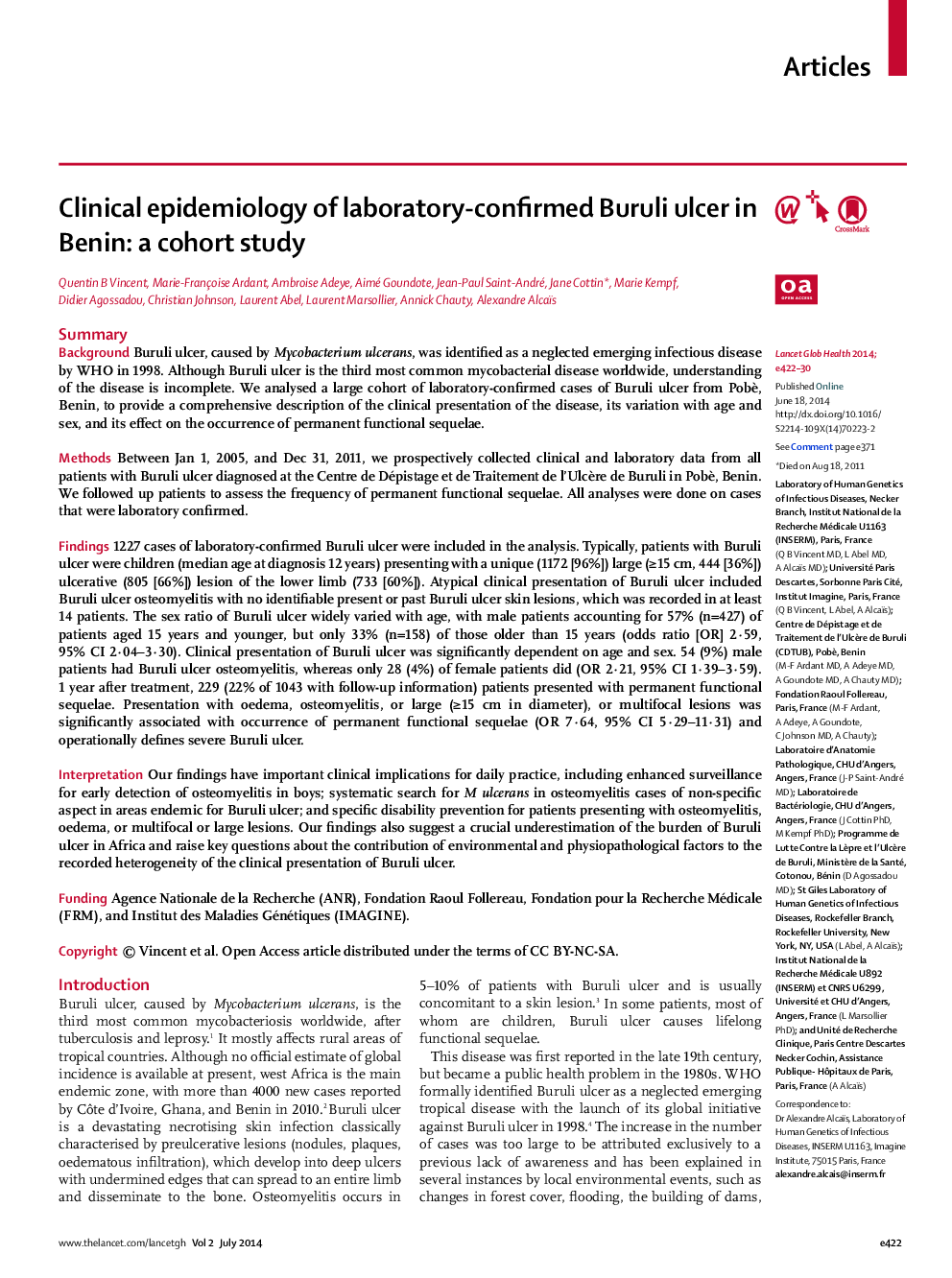| Article ID | Journal | Published Year | Pages | File Type |
|---|---|---|---|---|
| 3409442 | The Lancet Global Health | 2014 | 9 Pages |
SummaryBackgroundBuruli ulcer, caused by Mycobacterium ulcerans, was identified as a neglected emerging infectious disease by WHO in 1998. Although Buruli ulcer is the third most common mycobacterial disease worldwide, understanding of the disease is incomplete. We analysed a large cohort of laboratory-confirmed cases of Buruli ulcer from Pobè, Benin, to provide a comprehensive description of the clinical presentation of the disease, its variation with age and sex, and its effect on the occurrence of permanent functional sequelae.MethodsBetween Jan 1, 2005, and Dec 31, 2011, we prospectively collected clinical and laboratory data from all patients with Buruli ulcer diagnosed at the Centre de Dépistage et de Traitement de l'Ulcère de Buruli in Pobè, Benin. We followed up patients to assess the frequency of permanent functional sequelae. All analyses were done on cases that were laboratory confirmed.Findings1227 cases of laboratory-confirmed Buruli ulcer were included in the analysis. Typically, patients with Buruli ulcer were children (median age at diagnosis 12 years) presenting with a unique (1172 [96%]) large (≥15 cm, 444 [36%]) ulcerative (805 [66%]) lesion of the lower limb (733 [60%]). Atypical clinical presentation of Buruli ulcer included Buruli ulcer osteomyelitis with no identifiable present or past Buruli ulcer skin lesions, which was recorded in at least 14 patients. The sex ratio of Buruli ulcer widely varied with age, with male patients accounting for 57% (n=427) of patients aged 15 years and younger, but only 33% (n=158) of those older than 15 years (odds ratio [OR] 2·59, 95% CI 2·04–3·30). Clinical presentation of Buruli ulcer was significantly dependent on age and sex. 54 (9%) male patients had Buruli ulcer osteomyelitis, whereas only 28 (4%) of female patients did (OR 2·21, 95% CI 1·39–3·59). 1 year after treatment, 229 (22% of 1043 with follow-up information) patients presented with permanent functional sequelae. Presentation with oedema, osteomyelitis, or large (≥15 cm in diameter), or multifocal lesions was significantly associated with occurrence of permanent functional sequelae (OR 7·64, 95% CI 5·29–11·31) and operationally defines severe Buruli ulcer.InterpretationOur findings have important clinical implications for daily practice, including enhanced surveillance for early detection of osteomyelitis in boys; systematic search for M ulcerans in osteomyelitis cases of non-specific aspect in areas endemic for Buruli ulcer; and specific disability prevention for patients presenting with osteomyelitis, oedema, or multifocal or large lesions. Our findings also suggest a crucial underestimation of the burden of Buruli ulcer in Africa and raise key questions about the contribution of environmental and physiopathological factors to the recorded heterogeneity of the clinical presentation of Buruli ulcer.FundingAgence Nationale de la Recherche (ANR), Fondation Raoul Follereau, Fondation pour la Recherche Médicale (FRM), and Institut des Maladies Génétiques (IMAGINE).
